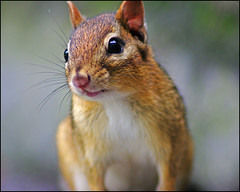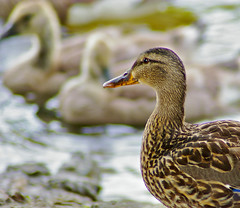|
| Author | Thread |
|
|
12/28/2008 01:41:27 PM · #351 |
Originally posted by rdebruyn:
Originally posted by hahn23:
Originally posted by jhomrighaus:
... The background was not a consideration in the composition of the shot, it is all about the Elk, I doubt you asked him to stand in that location so you could capture that particular background to leave the impression that the elk was in the woods..... |
The background was absolutely a consideration in the framing of this shot. I had to move my feet a lot to get into position to photograph the elk with a distant background (much separation) and not include the bright overcast sky and not spook the big critter and keep the sun (obscured by clouds) on the back of my shoulders. I had plenty of images of the big guy with a more traditional bokeh background w/o snow, but the falling snow made the shot interesting to me. This shot was from a tripod mount and I precisely made sure the focus was nailed on his face. It was a capture taken with this challenge in mind. Certainly, the image has weaknesses, but lack of bokeh is not one of the weaknesses. |
It's almost as though jhomrighaus thinks we happen upon a pretty picture, pull out our point and shoot and snap a quick shot to look at later. Ergo the pictures we come up with have no thought put into them. Oh! ...and none of us took any consideration of the quality of the bokeh and how it would add to the shot even though it was a bokeh challenge.
jhomrighaus I read through the first 5 topics you sent me. They predominently talk about the quality of the bokeh and not how it's used to create a better shot. I still challenge you to QUOTE sources in discussion - not list the first 2 pages of links from a google search. BTW I didn't choose the first google result of wikipedia. I searched for the wikipedia page on bokeh. |
This in particular was the passage which opened my eyes to the larger idea of Bokeh from the first link I provided;
"Actually, to be precise, what I had noticed was not just that people mispronounced the word as it was commonly spelled, but that they had a tendency to ridicule it, making lame jokes about it as if it rhymed with "smoke" or "toke" or "joke." Actually, even spelled boke, it is properly pronounced with bo as in bone and ke as in Kenneth, with equal stress on either syllable. It is a Japanese word meaning, roughly, "fuzzy," and it is used to describe old people with cobwebs in their heads among several other things — including the out-of-focus areas of photographs, which, I'm told, might more specifically be referred to as "boke-aji."
One of the curious aspects of the phenomenon for me was that some people then, and some even now, respond to the idea scornfully or even angrily. Is this some sort of insistence on conformity, as if you are supposed to look at certain parts of pictures and not others? I never did know, and I probably never will. (But then, there are a lot of things about my native culture that I will just never understand — for instance, rubber suits as erotic accessories, or why it would occur to anyone to hate black people. What's up with that, anyway? I mean, I certainly know that race hatred exists — I just haven't got the faintest idea why).
Now, I have to admit that I got somewhat obsessed with bokeh after I finally became aware of it. It interested me, in particular, that different lenses render blur in different ways. Even knowing that I take things a bit too far, though, it always seemed strange to me that there are people who don't think it's valid to look at the blurry parts of pictures.
Take this picture by Tony Rowlett, for example. It was made with a Leica Noctilux at a fairly wide aperture. I don't think it's possible to look at this and not get interested in what's going on in the out of focus areas, do you? If you really look at it, there are some pretty amazing abstracted shapes and tones. Does anyone really look at a picture like this and completely ignore all the blurry parts? I doubt it."
|
|
|
|
12/28/2008 07:00:52 PM · #352 |
Originally posted by jhomrighaus:
This in particular was the passage which opened my eyes to the larger idea of Bokeh from the first link I provided;
"Actually, to be precise, what I had noticed was not just that people mispronounced the word as it was commonly spelled, but that they had a tendency to ridicule it, making lame jokes about it as if it rhymed with "smoke" or "toke" or "joke." Actually, even spelled boke, it is properly pronounced with bo as in bone and ke as in Kenneth, with equal stress on either syllable. It is a Japanese word meaning, roughly, "fuzzy," and it is used to describe old people with cobwebs in their heads among several other things — including the out-of-focus areas of photographs, which, I'm told, might more specifically be referred to as "boke-aji."
One of the curious aspects of the phenomenon for me was that some people then, and some even now, respond to the idea scornfully or even angrily. Is this some sort of insistence on conformity, as if you are supposed to look at certain parts of pictures and not others? I never did know, and I probably never will. (But then, there are a lot of things about my native culture that I will just never understand — for instance, rubber suits as erotic accessories, or why it would occur to anyone to hate black people. What's up with that, anyway? I mean, I certainly know that race hatred exists — I just haven't got the faintest idea why).
Now, I have to admit that I got somewhat obsessed with bokeh after I finally became aware of it. It interested me, in particular, that different lenses render blur in different ways. Even knowing that I take things a bit too far, though, it always seemed strange to me that there are people who don't think it's valid to look at the blurry parts of pictures.
Take this picture by Tony Rowlett, for example. It was made with a Leica Noctilux at a fairly wide aperture. I don't think it's possible to look at this and not get interested in what's going on in the out of focus areas, do you? If you really look at it, there are some pretty amazing abstracted shapes and tones. Does anyone really look at a picture like this and completely ignore all the blurry parts? I doubt it." |
What I get from this is that bokeh is not just a part of a shot to be ignored. I fully agree with that. Even when the bokeh has no detail, it can hold interest in the color(s), how they complement the subject and (I would call it) the texture. I think you referenced one shot as having a "melted butter soft and smooth" bokeh.
I also feel that the OOF background can hold more interest or less and still be a bokeh shot.
Example of less:

Example of more:

|
|

|
|
Current Server Time: 04/19/2024 02:08:32 PM  |
Home -
Challenges -
Community -
League -
Photos -
Cameras -
Lenses -
Learn -
Prints! -
Help -
Terms of Use -
Privacy -
Top ^
DPChallenge, and website content and design, Copyright © 2001-2024 Challenging Technologies, LLC.
All digital photo copyrights belong to the photographers and may not be used without permission.
Current Server Time: 04/19/2024 02:08:32 PM EDT.
|

